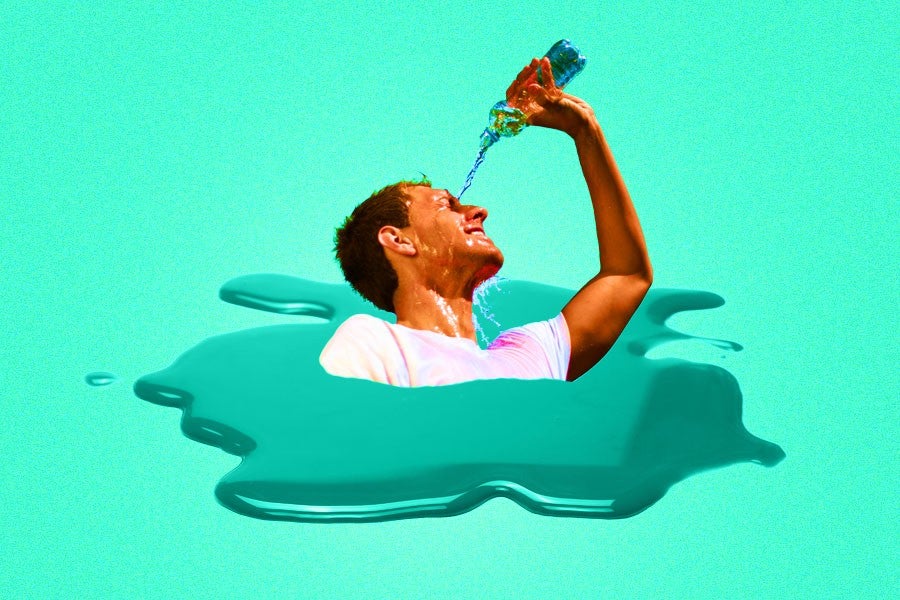Are you one of those guys who wants to look stylish but finds it doesn’t come all that naturally? Sick of condescending fashion articles telling you why you need to buy $200 T-shirts? Just want to know how to look, well, good? We feel you. Welcome to “Help Me Dress Myself,” an advice column for men who just want some practical advice for not looking like crap.

The Question
Sadly, waterpark attire isn’t acceptable at my place of work, and I can’t leave the house without sweating through every reasonable article of clothing that I own. Since I’d prefer to avoid heat stroke this summer, but I don’t know what to wear without looking like I should also have a boogie board under my arm… help?
The Expert Advice
Patrick Taylor, Death Valley National Park Ranger: Until temperatures reach 98 degrees, it’s best to wear clothing that lets your body discharge heat as much as possible (shorts, short-sleeve shirts, etc.) Once the temperature exceeds 98 degrees, it’s better to wear lightweight, long-sleeve clothing to provide protection from the sun and retain more moisture in and around your body. Of course, wearing a wide-brim hat to shield your face and neck is also important.
Rangers stop buying new clothes when we get hired because we wear uniforms five days a week, so you can usually tell when someone got their first job by the type of clothing they wear on the weekends (e.g., hammer pants, Shaq-era L.A. Lakers championship T-shirts).
That said, I’d suggest that there’s a notable difference between loose-fitting lightweight clothing and baggy clothing. One look says that you’re ready to enjoy the summer outdoors — the other says that you got a free T-shirt. Stetson or straw hats work well and look nice (though, nothing looks as good as a park ranger flat hat). Most rangers tend to wear neutral, natural colors when they’re not in uniform, but for those looking to make a statement, colors like red and blue tend to stand out from the scenic backdrops.
David Heiman, instructor at The Refrigeration School: As an HVAC technician and instructor at The Refrigeration School, I often work on rooftops in the middle of summer in Arizona and know how tricky it can be to keep cool in boiling weather. Most would think to wear as little clothing as possible, but to protect yourself from the harsh sun, it’s actually better to cover up with long-sleeve shirts and pants. I typically wear light-colored Under Armor shirts and light-colored pants. HVAC technicians also often wear light gloves that are protective, yet breathable, a big floppy hat, safety glasses and a lot of sunscreen.
The most important thing, however, is hydration. I personally stay away from caffeine and alcohol on any day I’m working outside, and drink lemon or lime-flavored sports drinks. Hydrate for tomorrow today, so bring at least two gallons of water with you and drink it each day, including on the weekends.
Malcolm Wells, Future Park Leader Intern at the South Florida/Caribbean Network of the National Park Service: Dressing for heat is about being responsive to your environment — different items of clothing function differently in different “heats.” For example, a baseball cap can provide much-needed shade in the sun, but under the shade of a big tree, a baseball cap might only function to retain your body heat, therefore, keeping you hot.
The basic rule of thumb for intense heat is lightweight long-sleeve clothing (that includes pants) — no heat is too hot to risk sun exposure! Another important thing is wearing a hat and/or sunglasses. While sunglasses don’t actually protect from the heat, a lot of that “hot experience” is perception, and sunglasses give us the appearance that we’re in the shade, and consequently, we feel cooler.
Erik Klemetti, Volcanologist: In 2013, I visited a lava flow on Kilauea [a currently active shield volcano]. It was a small flow in Puna that was coming from the now-defunct Puʻu ʻŌʻō vent. We were going out to sample the lava with our rock hammers, and it was the first time I’d been to an actual lava flow. Now, I had no idea what to expect, but our guide from the Hawaiian Volcano Observatory said that we needed long pants, long-sleeve shirts, gloves, a bandana or mask for our mouths and nose, along with a hat and goggles/sunglasses. This all seemed extreme to me, but I had no idea how hot it was going to feel.
When we finally got to the lava, I could see the ground glowing between cracks in the hard surface. Within 10 to 15 feet of the actual flowing lava, it felt like you were sticking your head into a BBQ grill. The lava is four times hotter (or more) than you can get your oven to go on broil. Even the few seconds that I was sticking my rock hammer in the lava flow, it was unbearably hot and I couldn’t stand there for more than a few seconds. It cooled very fast, but was still way too hot to touch for 20 to 30 minutes afterwards, even when it looked black and hardened (the “freezing” point for lava is more than 1,000 degrees Fahrenheit). I’ve never experienced anything as hot as being near that lava flow, not even the 110-degree days when I lived in Davis, California.
So, if you’re near lava, you want to do the opposite of what you normally would to dress for hot weather: You need to protect yourself from such intense heat. Outfitted volcanologists wear full thermal suits (those silver ones) to reflect the heat. It’s just that hot. If you think it’s hot now, it ain’t nothing compared to a lava flow.

